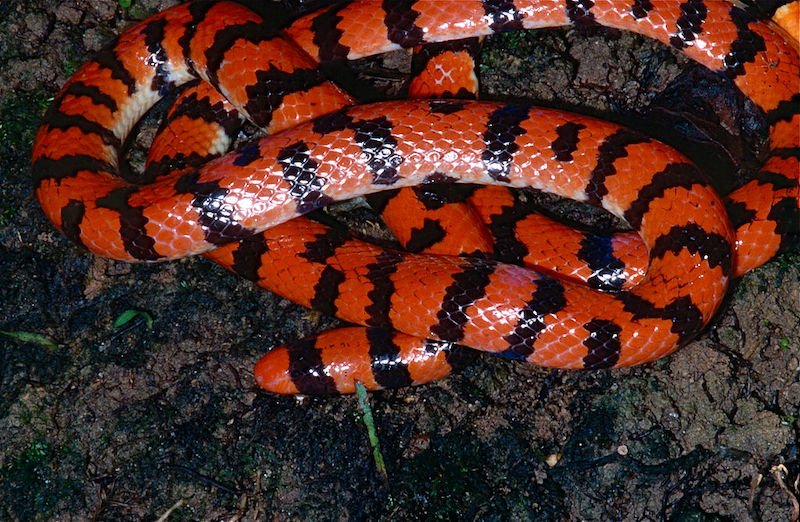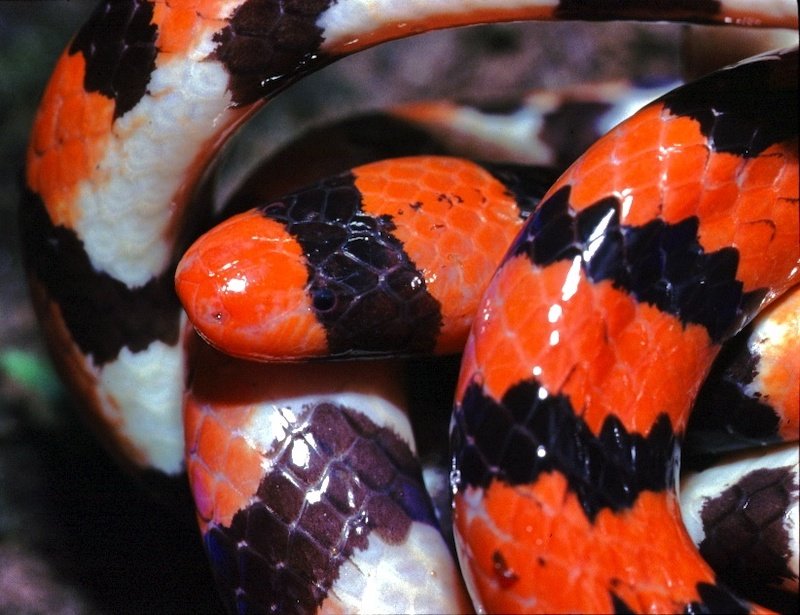Colorful Cobra Mimic
Bernard DUPONT from FRANCE, CC BY-SA 2.0, via Wikimedia Commons
Aniliidae
by Inspector Barry Mins on December 5, 2023Hey kids, welcome back to our series on the mysteries of created kinds.
Before we meet this week’s kind—ChristmasTown is happening at the Creation Museum. If you live in the area, ask your parents to bring you to see the lights and other events on the grounds. You also might see Cormelius. He’s found a friend floating on the lake, and he likes to hang out there in the sunshine, drying his wings.

Now let’s meet this week’s kind.

This week we head to the jungles of northern South America looking for a very colorful snake. There is just one species in this kind, and they normally come with red and black stripes—mimicking dangerous venomous snakes. However, specimens have been observed with different patterns, including crème and black,1 or red and silver.2 When threatened, the snake will bury its head under its body and raise its tail in the posture of a cobra, swinging it from side to side to scare the predator.3
Members of this kind are predators with a very wide diet. They will eat worm lizards4 and other amphibians, along with the odd fish.5 In at least some situations, the snake will constrict its prey before swallowing it headfirst.6
Has anyone figured it out yet? This week’s kind is the Aniliidae—the false coral snake kind. Stay tuned for next week when we move to Australia to find a small marsupial kind.
Try out this fun Crossword Puzzle!
Clue
Your clue for the week is:
This kind looks something like a small wallaby or kangaroo.
Ask a Question
Have you ever had a question about created kinds but didn’t know who to ask? Have you ever wanted to learn more about your favorite kind? Well, now you can! You can ask me, Inspector Barry Mins, a question! Have your parents help you fill out this form, and you might get your question answered in my column! If you have any questions about created kinds, feel free to send them my way!
Footnotes
- A. D. Abegg, R. C. Cruz-da-Silva, and M. A. de Freitas, “A remarkable specimen of the genus Anilius (Serpentes: Aniliidae): rare colour aberration or a new species?” Herpetology Notes 11 (2018): 161–165.
- L. R. Rivas, V. A. Vos, C. B. Eversole, R. Powell, and R. D. Layme, “First report of hypomelanism in Anilius scytale (Linnaeus, 1758) (Squamata: Aniliidae) from the Bolivian Amazon,” Herpetology Notes 16 (2023): 493–495.
- R. J. Sawaya, “The defensive tail display of Anilius scytale (Serpentes: Aniliidae),” Herpetology Notes 3 (2010): 249–250.
- R. A. Pommer-Barbosa, J. F. T. Reis, J. R. Evangelista, W. P. Ferreira, S. de Albuquerque, M. A. Oliveira, and A. L. da C. Prestes, “Predation on Amphisbaena fuliginosa Linnaeus, 1758 by Anilius scytale (Linnaeus, 1758) in the southwestern Brazilian Amazon,” Herpetology Notes 15 (2022): 615–617.
- G. F. Maschio, A. L. da C. Prudente, F. da S. Rodrigues, and M. S. Hoogmoed, “Food habits of Anilius scytale (Serpentes: Aniliidae) in the Brazilian Amazonia,” Zoologia (Curitiba Impresso) 27, no. 2 (2010): 184–190.
- I. Sazima and O. A. V. Marques, “Winding to and fro: constriction in the snake Anilius scytale,” Herpetological Bulletin 103 (2008): 29–31.
- © 2024 Answers in Genesis
- Privacy Policy
- Contact
- About


